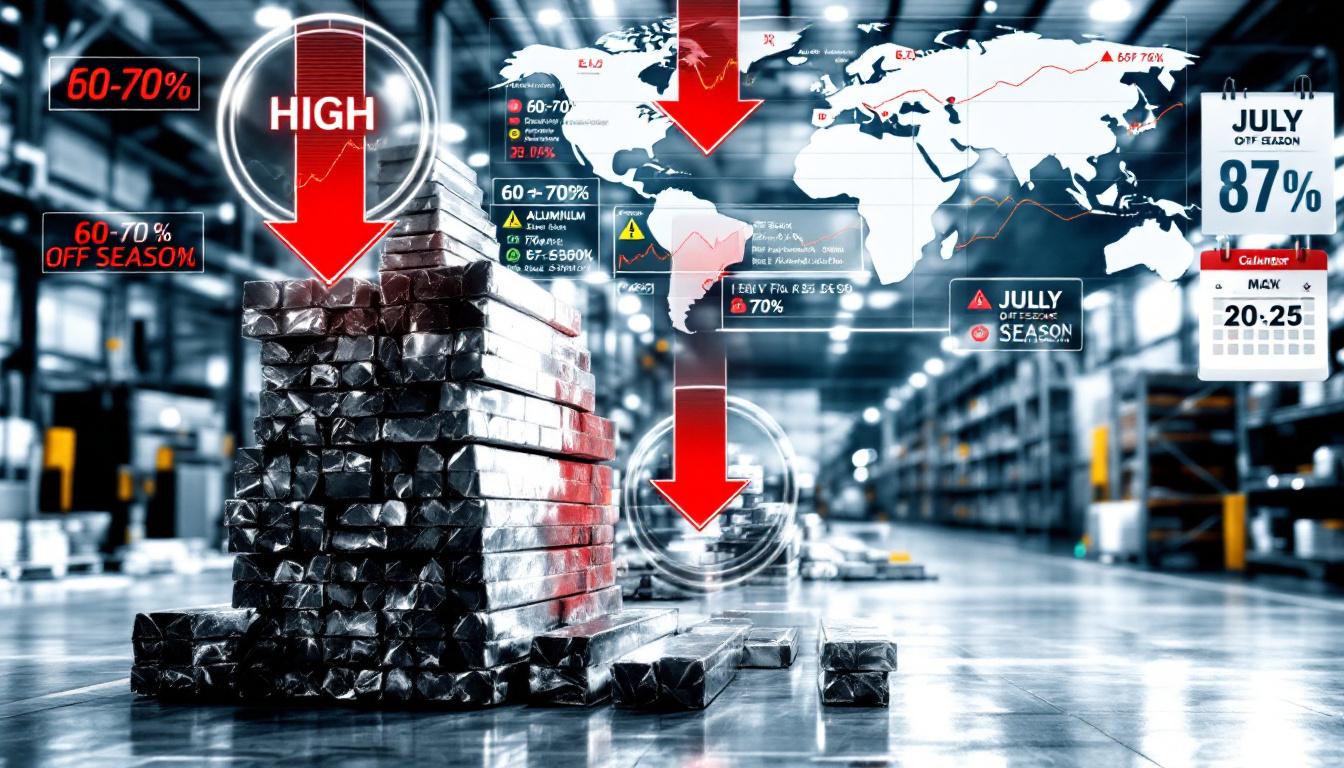What Is Causing Recent LME Zinc Price Volatility?
The Approaching US Tariff Deadline
Market uncertainty is intensifying as the July 9th deadline for US tariffs on previously untaxed countries rapidly approaches. According to data from Shanghai Metal Market (SMM), this deadline is creating significant apprehension among traders and investors in the zinc market, with participants showing increased caution as implementation draws near.
"The impending tariff implementation has created a cloud of uncertainty over global metal markets, with zinc particularly vulnerable due to its extensive cross-border supply chains," notes SMM's latest market analysis. This vulnerability stems from zinc's critical role in steel galvanizing, which represents approximately 60% of global zinc consumption.
The potential economic ripple effects extend far beyond immediate price adjustments. If implemented as expected, these tariff policy impacts could disrupt established trade flows, forcing producers to reconsider supply routes and potentially creating regional price disparities that didn't previously exist.
Recent Price Performance Analysis
LME zinc closed at $2,735.5/mt on Friday, representing a marginal decline of $2.5/mt (0.09%) from the previous session. This seemingly minor movement masks more significant intraday volatility, characterized by an initial upward surge to $2,757/mt before consistent downward pressure brought prices lower.
Trading metrics revealed declining market participation, with volume decreasing to 4,385 lots while open interest fell by 883 lots to 206,000 lots. This reduction in both volume and open interest suggests traders are unwinding positions ahead of the tariff deadline, preferring to reduce exposure during this period of heightened uncertainty.
Meanwhile, on the Shanghai Futures Exchange (SHFE), zinc's most-traded 2508 contract closed at 22,240 yuan/mt, down 170 yuan/mt (0.76%). The synchronized downward movement across both exchanges indicates global market sentiment is aligned in its cautious approach to the upcoming tariff deadline and its impact on LME zinc prices.
The technical chart pattern for both LME and SHFE zinc showed small bearish candlesticks, indicating consolidation with mild downward pressure—a classic market response to approaching policy uncertainty.
How Are Global Macroeconomic Factors Influencing Zinc Markets?
US Political and Trade Developments
Recent reports from SMM indicate the Trump administration is signaling the potential for 12-15 tariff-related communications on Monday, creating a heightened sense of anticipation and uncertainty in metal markets. These communications could significantly alter global trade dynamics for zinc and other metals.
Adding to market complexity, there are indications that some trade negotiations may extend beyond the established July 9th deadline, creating a patchwork of implementation timelines that complicates trading strategies and supply chain planning.
The recent signing of new tax and spending legislation has further contributed to economic policy uncertainty. Market analysts note that fiscal policy changes can impact construction and infrastructure development—key sectors for zinc consumption through galvanized steel products.
Political developments, including the formation of the "America Party," are introducing additional volatility into markets. While the direct impact on zinc prices remains to be quantified, increased US tariff effects typically correlate with market hesitancy and risk-averse positioning.
International Geopolitical Tensions
Beyond trade policy, broader geopolitical factors are weighing on commodity markets. SMM reports that US Defense Secretary Hegseth has suspended arms shipments to Ukraine, representing a significant shift in US foreign policy that has rattled global markets and added another layer of uncertainty for metal traders.
Simultaneously, unresolved Israel-Hamas ceasefire negotiations in Qatar continue to create tension in the Middle East, a region critical for global energy supplies and trade routes. While zinc production isn't concentrated in this region, oil market trends can significantly impact smelter operations and transportation costs.
The recent OPEC+ agreement to increase oil production for August could potentially ease some cost pressures across commodity markets, including zinc. Energy represents approximately 30-40% of zinc smelting costs, making production economics highly sensitive to energy price movements.
Chinese Economic Policies
China's Ministry of Finance has implemented countermeasures against EU medical device imports in government procurement, signaling increased trade tensions between major economic blocs. While not directly targeting metals, this development suggests a broader pattern of trade retaliation that could eventually impact industrial materials like zinc.
More directly relevant to zinc markets is the announcement from China's Housing and Urban-Rural Development Ministry regarding increased efforts to stabilize the real estate market. Given that construction accounts for roughly 45-50% of zinc consumption in China, any policies that stimulate or restrict building activity have outsized impacts on zinc demand.
"More efforts will be made to promote the stabilization and recovery of the real estate market," according to the Ministry statement reported by SMM, highlighting the government's commitment to supporting a sector critical for zinc consumption.
These housing support measures could potentially offset some of the negative pressure from US trade tensions, creating a complex demand picture for zinc in the world's largest consuming nation.
What's Happening in Regional Zinc Spot Markets?
Shanghai Market Conditions
Shanghai's zinc spot market is experiencing increased trader offerings coinciding with high futures prices, creating a somewhat paradoxical market condition. Despite ample supply from traders, SMM reports that buying sentiment has been significantly dampened, with downstream buyers limiting purchases to essential needs.
Just-in-time procurement strategies have become prevalent among manufacturers, with many refusing to build inventory amid market uncertainty. This strategic approach has led to reduced spot transactions despite adequate material availability.
The cautious buying sentiment has forced a pullback in spot premiums as traders compete for limited transaction volume. This premium compression reflects the market's adjustment to weakened demand fundamentals despite relatively tight inventory statistics.
According to SMM data, these conditions have created a disconnection between futures pricing and physical market reality, with physical premiums failing to maintain previous levels despite supportive macro indicators.
Guangdong Market Dynamics
The Guangdong region continues to face sluggish downstream consumption, creating persistent demand challenges for zinc traders and producers. SMM reports that price fluctuations have further reduced procurement enthusiasm, with buyers increasingly sensitive to price movements.
In response to these challenging conditions, traders have been lowering premiums to stimulate sales, though with limited success. Transaction volumes remain "relatively average" according to SMM's market assessment, reflecting the fundamental demand weakness plaguing the region.
Friday's trading session saw a continuing decline in spot premiums, confirming the ongoing pressure on physical market pricing. This trend of weakening premiums despite stable headline prices suggests that official exchange quotations may be overestimating actual market strength.
The persistence of these conditions in Guangdong, a major industrial hub, raises concerns about the broader health of zinc-consuming industries in China's manufacturing heartland.
Northern China Markets (Tianjin and Ningbo)
Weather disruptions, specifically heavy rainfall in Tianjin, have further complicated market conditions by affecting downstream operations. This environmental factor has compounded already reduced buying sentiment across both northern regions, according to SMM data.
Despite these challenges, trader quotes have remained relatively stable, indicating reluctance to discount material despite poor transaction volumes. This price stability amid weak demand suggests traders may be anticipating improved conditions following resolution of the tariff uncertainty.
Just-in-time purchasing strategies continue to dominate buyer behavior in both Tianjin and Ningbo, with procurement strictly limited to immediate production needs. This cautious approach has resulted in overall transaction volumes that SMM characterizes as "poor to mediocre."
The persistence of weak physical market conditions across multiple major Chinese trading hubs paints a concerning picture for near-term zinc demand, regardless of how the upcoming tariff deadline and its impact on LME zinc prices eventually materializes.
How Are Zinc Inventory Levels Affecting Market Sentiment?
Global Inventory Movements
LME zinc inventory decreased by 350 mt (0.31%) to 112,325 mt as of July 4, according to official exchange data cited by SMM. This modest decline in global exchange stocks occurs against a backdrop of rising inventories in China.
SMM-tracked inventory across seven locations reached 82,400 mt, representing a week-over-week increase of 2,900 mt from June 26. More recently, stocks have risen by 1,800 mt from June 30, indicating an accelerating pace of inventory accumulation in the world's largest consuming nation.
This divergence between declining global exchange stocks and rising Chinese domestic inventories creates a complex picture for analysts attempting to gauge overall market balance. The trend suggests potential weakening of Chinese consumption relative to the rest of the world.
These inventory movements are particularly significant given zinc's relatively small global stockpile compared to annual consumption, making even modest changes potentially impactful for price direction.
Inventory Impact on Pricing
The domestic inventory buildup in China is creating increasingly bearish sentiment in Chinese markets, with traders concerned about continued accumulation amid weak downstream demand. However, as SMM notes, relatively low overall social inventory levels continue to provide price support, preventing a more dramatic price decline.
Market expectations regarding inventory fluctuations are creating additional uncertainty, with traders closely monitoring weekly stock reports for signals of demand recovery or further deterioration. This heightened focus on inventory data has increased price volatility around report releases.
There is potential for continued inventory growth amid weak consumption patterns, particularly if weather disruptions and macroeconomic uncertainties persist. Historical patterns suggest summer months often see seasonal inventory builds in China's zinc market due to construction slowdowns.
The current inventory levels, while rising, remain below historical averages for this time of year, providing some fundamental support for prices despite immediate bearish pressure from recent stock increases.
What Technical Factors Are Influencing Zinc Price Movement?
Price Pattern Analysis
LME zinc recorded a small bearish candlestick pattern on Friday, providing technical traders with confirmation of near-term downward momentum. This pattern emerged after testing resistance around the $2,750/mt level, suggesting sellers remain active at higher price points.
SHFE zinc mirrored this pattern with similar bearish momentum, creating a synchronized technical picture across global zinc trading venues. This harmonized movement indicates global macro factors are currently outweighing regional considerations in driving price action.
Price consolidation within established ranges suggests market indecision ahead of the tariff deadline, with neither bulls nor bears willing to commit significant capital to directional positions. This consolidation pattern typically precedes increased volatility once clarity emerges on policy direction.
Support and resistance levels are being closely tested as the tariff deadline approaches, with $2,700/mt emerging as a key psychological support level for LME zinc. Technical analysts note that a break below this threshold could accelerate selling pressure toward the $2,650/mt region.
Trading Volume and Open Interest
Declining trading volumes on both LME and SHFE indicate potential market hesitation as participants reduce exposure ahead of potential policy shifts. This volume contraction is a classic signal of market uncertainty, with traders preferring to observe from the sidelines rather than take positions.
The reduction in open interest—down 883 lots on LME and 1,726 lots on SHFE—suggests position unwinding ahead of the tariff deadline as market participants reduce risk exposure. This simultaneous decline in both volume and open interest typically precedes market inflection points.
Shifting market participation patterns are emerging as uncertainty increases, with shorter-term traders dominating volume while longer-term position holders reduce exposure. This changing market composition often leads to increased short-term volatility and reduced market liquidity.
Technical analysts anticipate potential for increased volatility as the deadline approaches, with the possibility of sharp price movements once policy details become clear. Historical patterns suggest metals often experience their largest price movements in the immediate aftermath of major policy announcements.
What's the Short-Term Outlook for Zinc Prices?
Market Sentiment Indicators
Increasing concerns about tariff implementation are driving cautious positioning across the zinc market. SMM reports that traders are reluctant to build significant positions in either direction until policy clarity emerges after July 9th.
Poor domestic consumption in China continues to pressure prices despite relatively supportive technical factors. This fundamental weakness represents a significant headwind for any sustained price recovery, regardless of how tariff policies eventually materialize.
The ongoing inventory buildup, particularly in China, is creating additional headwinds for price recovery. Rising stocks typically signal weakening demand or oversupply, both bearish factors for price direction.
Despite these bearish factors, low absolute inventory levels globally provide foundational price support, preventing a more dramatic price collapse. This underlying tightness in physical metal availability creates a floor for prices even amid temporary demand weakness.
Price Forecast Considerations
SHFE zinc is expected to consolidate with fluctuations in the immediate term, according to SMM's latest market assessment. This sideways-but-volatile pattern would align with historical market behavior during periods of policy uncertainty.
There is significant potential for increased volatility as the tariff deadline approaches, with potential for sharp price movements once policy details become clear. Traders should prepare for widened trading ranges and potential liquidity challenges around the announcement period.
The market will likely remain highly sensitive to any trade policy announcements, with potential for overreactions to both positive and negative developments. This sensitivity creates both risk and opportunity for well-positioned traders.
Downstream demand patterns will be critical for determining price direction once tariff policies are clarified. If Chinese construction and manufacturing activity shows signs of recovery, zinc prices could find support despite trade headwinds. Conversely, continued weakness in these sectors would likely exacerbate any negative tariff impacts.
FAQ About Zinc Markets and Tariff Impacts
How do tariffs typically affect metal prices?
Tariffs generally create price disparities between markets, with prices often rising in countries implementing tariffs due to reduced supply competition. This occurs because tariffs effectively increase the cost of imported material, allowing domestic producers to raise prices while remaining competitive against imports.
However, global prices may decline if demand destruction occurs or if producers redirect supply to non-tariffed markets, creating oversupply conditions. This "trade diversion" effect can lead to regional price discrepancies that create arbitrage opportunities for traders while complicating supply chain planning for manufacturers.
For zinc specifically, tariffs can disrupt the complex web of concentrate production, smelting, and refining that often crosses multiple borders before reaching end users. With approximately 40% of global zinc production traded internationally, tariff impacts can be particularly pronounced.
"Tariffs create artificial market distortions that inevitably lead to inefficient resource allocation and higher costs for downstream consumers," notes a recent analysis from Metal.com.
What industries are most affected by zinc price volatility?
Galvanizing for steel products represents approximately 60% of zinc consumption, making construction, automotive manufacturing, and infrastructure development particularly sensitive to zinc price changes. In these sectors, zinc typically represents 3-8% of total material costs, making significant price swings immediately noticeable in production economics.
Consumer electronics, die-casting, and brass manufacturing are also significantly affected by zinc price volatility. The electronics sector is particularly sensitive due to thin profit margins and intense competition, with manufacturers often unable to pass increased material costs to consumers.
When zinc prices fluctuate rapidly, industries with longer contract cycles face margin compression as they may be locked into fixed-price sales agreements while facing variable input costs. This asymmetric risk exposure makes predictable pricing crucial for financial planning.
Industries with just-in-time inventory management systems are particularly vulnerable to supply disruptions that might accompany tariff implementation, as they lack buffer inventories to absorb short-term supply chain disruptions.
How do inventory levels influence zinc price movements?
Inventory levels serve as a key indicator of market balance. Declining inventories typically signal tightening supply conditions and support higher prices, as they suggest demand is outpacing available supply. This relationship is particularly strong when inventories fall below critical thresholds that indicate potential physical shortages.
Increasing inventories suggest weakening demand or oversupply, generally putting downward pressure on prices. However, context matters significantly—inventory builds during typically high consumption periods are more bearish than seasonal builds during expected slowdowns.
The rate of inventory change often matters more than absolute levels, with accelerating inventory draws or builds triggering stronger price reactions than gradual changes. Market participants closely monitor week-over-week changes for early signals of shifting fundamentals.
Location of inventories also matters significantly, with stocks in accessible locations and deliverable brands having more immediate price impact than remote or non-deliverable material. This explains why changes in exchange-registered inventories typically have outsized price impacts compared to off-warrant stocks.
What role does China play in global zinc markets?
China represents approximately 50% of global zinc consumption and is the world's largest producer, making its economic indicators, construction activity, and policy decisions critical for global zinc supply-demand dynamics and pricing.
The country's strategic importance has grown as its share of global zinc consumption has increased from roughly 35% in 2010 to current levels, making Chinese demand trends increasingly determinative for global market balance.
China's role is particularly significant given its position across the entire zinc value chain—from mining operations and concentrate production to smelting, refining, and consumption in manufactured goods. This vertical integration gives Chinese market participants unique insights into supply-demand fundamentals.
Government policies affecting construction, infrastructure development, and environmental regulations have immediate and significant impacts on zinc market balance. For example, recent efforts to stabilize China's real estate market directly influence approximately half of the country's zinc consumption through galvanized steel requirements.
Additionally, ongoing China steel challenges continue to shape the trajectory of zinc demand, as approximately 60% of zinc is used for galvanizing steel products to prevent corrosion.
Ready to Stay Ahead of Critical Market Movements?
Discover how Discovery Alert's proprietary Discovery IQ model delivers instant notifications on significant ASX mineral discoveries, transforming complex data into actionable investment insights ahead of the market. Visit our discoveries page to see how historic mineral findings have generated exceptional returns and begin your 30-day free trial today.




